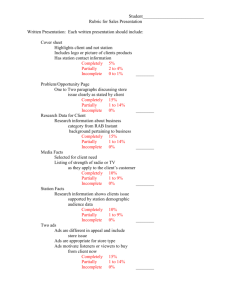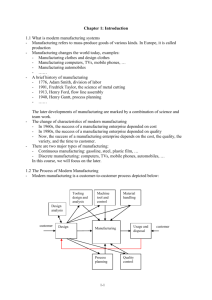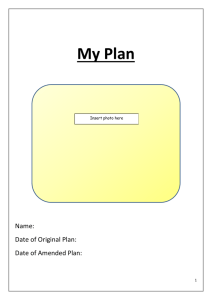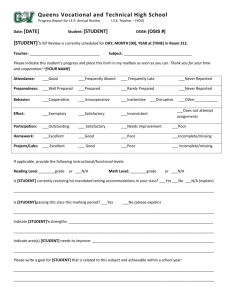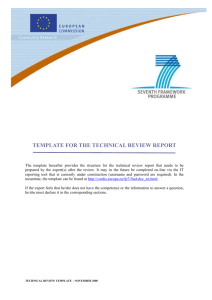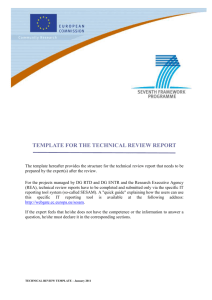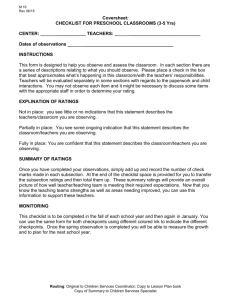Stages of Implementation Analysis: Where Are We?
advertisement
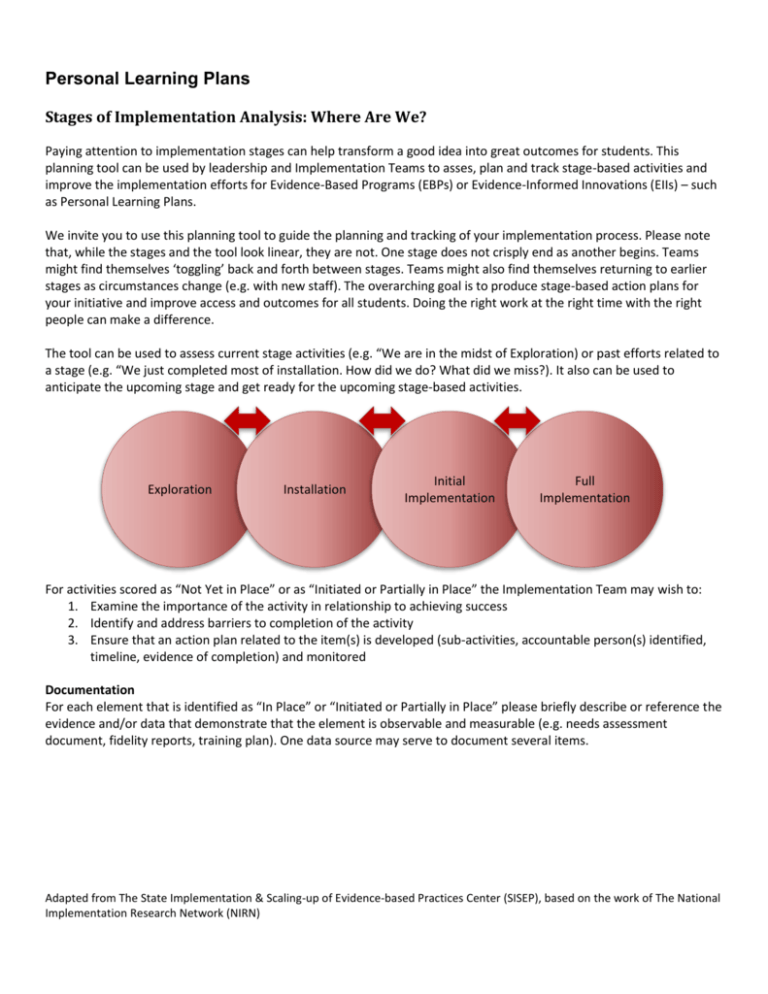
Personal Learning Plans Stages of Implementation Analysis: Where Are We? Paying attention to implementation stages can help transform a good idea into great outcomes for students. This planning tool can be used by leadership and Implementation Teams to asses, plan and track stage-based activities and improve the implementation efforts for Evidence-Based Programs (EBPs) or Evidence-Informed Innovations (EIIs) – such as Personal Learning Plans. We invite you to use this planning tool to guide the planning and tracking of your implementation process. Please note that, while the stages and the tool look linear, they are not. One stage does not crisply end as another begins. Teams might find themselves ‘toggling’ back and forth between stages. Teams might also find themselves returning to earlier stages as circumstances change (e.g. with new staff). The overarching goal is to produce stage-based action plans for your initiative and improve access and outcomes for all students. Doing the right work at the right time with the right people can make a difference. The tool can be used to assess current stage activities (e.g. “We are in the midst of Exploration) or past efforts related to a stage (e.g. “We just completed most of installation. How did we do? What did we miss?). It also can be used to anticipate the upcoming stage and get ready for the upcoming stage-based activities. Exploration Installation Initial Implementation Full Implementation For activities scored as “Not Yet in Place” or as “Initiated or Partially in Place” the Implementation Team may wish to: 1. Examine the importance of the activity in relationship to achieving success 2. Identify and address barriers to completion of the activity 3. Ensure that an action plan related to the item(s) is developed (sub-activities, accountable person(s) identified, timeline, evidence of completion) and monitored Documentation For each element that is identified as “In Place” or “Initiated or Partially in Place” please briefly describe or reference the evidence and/or data that demonstrate that the element is observable and measurable (e.g. needs assessment document, fidelity reports, training plan). One data source may serve to document several items. Adapted from The State Implementation & Scaling-up of Evidence-based Practices Center (SISEP), based on the work of The National Implementation Research Network (NIRN) Stage-Related Activities for Exploration In Place / Completed Partially in Place / Completed Learn and analyze the key elements of the legislation. Form “Implementation Team” or repurpose/expand a current group. Develop communication plan to describe the exploration process to key stakeholder groups. Analyze data to determine need and prevalence of need. Select targeted areas to address need. Review and identify programs, practices, interventions that match target area and address need. Review and discuss “eligible” activities / programs in relation to: Need Fit Resources - Sustainability Strength of Evidence Readiness for Replication Capacity to Implement Select programs/practices for continued exploration based on assessment results from above. Develop methods to gain “buy-in” for a range of impacted stakeholders. Analyze information and results of exploration activities. Implementation Team makes final selection or makes recommendation to appropriate level (e.g., next leadership level team, best practices groups, local partners, alliance, District leadership) for final selection. Not yet in Place / Incomplete Evidence for “In Place” or “Partially In Place” Components For “Incomplete Components”, identify action needed / notes: Stage-Related Activities for Installation In Place / Completed Partially in Place / Completed Not yet in Place / Incomplete Evidence for “In Place” or “Partially In Place” Components For “Incomplete Components”, identify action needed / notes: Make structural and functional changes needed (e.g. policies, schedules, space, time, materials, re-allocation of roles and responsibilities). Within classroom/building level Across the district Outside the district Development of selection protocols for “first practitioners”. Within classroom/building level Across the district Outside the district Selection of “first practitioners”. Within classroom/building level Across the district Outside the district Identification of training resources, logistics. Training of first implementers Develop coaching and support plans for teachers Analyze and problem-solve around the sustainability of training, coaching, data systems. Establish communication links to report barriers and facilitators to next leadership level and/or policymakers during next stage (e.g. Intitial Implementation). Stage-Related Activities for Initial Implementation In Place / Completed Partially in Place / Completed Not yet in Place / Incomplete In Place / Completed Partially in Place / Completed Not yet in Place / Incomplete Evidence for “In Place” or “Partially In Place” Components For “Incomplete Components”, identify action needed / notes: Communication plan(s) developed to inform stakeholders of dates, activities, and convey support. Communication protocols developed for identifying barriers and adaptive challenges and problem-solving at each level (e.g. monthly implementation team meetings to monitor progress, identify issues, create plans, forward issues to “next” level, if needed). Leadership develops support plan to promote ongoing efforts. Data systems functioning for measuring and reporting student outcomes. If appropriate, plan for next cohort of practitioners. Stage-Related Activities for Full Implementation Monitoring and support systems are in place. Feedback process from teachers to building and/or district administrators is in place and functional (e.g. Teacher participation on Leadership and Implementation Teams, changes in administrative supports and policies occur to facilitate best practices). Feedback process from Schools to next levels of administration in place and functional (e.g. School Leadership to District). Leadership and Implementation Teams use data (e.g. student outcomes, behavior, and fidelity) to make decisions. Evidence for “In Place” or “Partially In Place” Components For “Incomplete Components”, identify action needed / notes:
